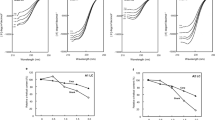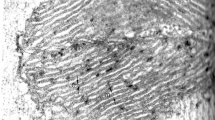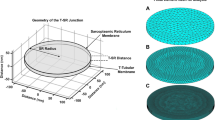Abstract
THE transfer of skeletal muscle fibres from Ringer solution containing 100–200 mM glycerol, urea or other low molecular hydrophilic non-electrolytes to normal Ringer leads to the development of vacuolation clearly visible under the light microscope1. In the case of glycerol efflux, vacuolation develops within a few minutes and persists for several hours, after which fibre structure is gradually restored to normal. Reimmersion of vacuolized fibres in glycerol-Ringer results in a rapid disappearance of vacuoles. The same effect is produced by the influx of some other low molecular non-electrolytes.
This is a preview of subscription content, access via your institution
Access options
Subscribe to this journal
Receive 51 print issues and online access
$199.00 per year
only $3.90 per issue
Buy this article
- Purchase on Springer Link
- Instant access to full article PDF
Prices may be subject to local taxes which are calculated during checkout
Similar content being viewed by others
References
Krolenko, S. A., Adamyan, S. Ja., and Schwiaka, N. E., Tsitologiya, 9, 1346 (1967).
Eisenberg, B., and Eisenberg, R. S., J. Cell Biol., 39, 451 (1968).
Krolenko, S. A., Tsitologiya, 10, 803 (1968).
Krolenko, S. A., Nature, 221, 966 (1969).
Howell, J. N., J. Physiol., 201, 515 (1969).
Krolenko, S. A., Tsitologiya, 12, (in the press).
Vinogradova, N. A., Doroshenko, N. V., Nikolsky, N. N., and Troshin, A. S., Biophisika, 13, 365 (1968).
Hodgkin, A. L., and Horowicz, P., J. Physiol., 148, 127 (1959).
Horowicz, P., Gage, P. W., and Eisenberg, R. S., J. Gen. Physiol., 51, 193s (1968).
Conway, E. J., Kernan, R. P., and Zadunaisky, J. A., J. Physiol., 155, 263 (1961).
Adrian, R. H., and Slayman, C. L., J. Physiol., 184, 970 (1966).
Foulks, J. G., Pacey, J. A., and Perry, F. A., J. Physiol., 180, 86 (1965).
Reger, J. F., Exp. Cell Res., 43, 435 (1966).
Girardier, L., Reuben, J. P., Brandt, P. W., and Grundfest, H., J. Gen. Physiol., 47, 189 (1963).
Brand, P. W., Reuben, J. P., and Grundfest, H., J. Cell Biol., 38, 115 (1968).
Selvestron, A., Amer. Zoologist, 7, 515 (1967).
Cochrane, D. G., and Elder, H., J. Physiol., 191, 30 (1967).
Tormey, J. McD., and Diamond, J. M., J. Gen. Physiol., 50, 2031 (1967).
Grantham, J. J., Ganote, Ch. E., Burg, M. B., and Orloff, J., J. Cell Biol., 41, 562 (1969).
Author information
Authors and Affiliations
Rights and permissions
About this article
Cite this article
KROLENKO, S. Effect of Fluxes of Sugars and Mineral Ions on the Light Microscopic Structure of Frog Fast Muscle Fibres. Nature 229, 424–426 (1971). https://doi.org/10.1038/229424a0
Received:
Issue Date:
DOI: https://doi.org/10.1038/229424a0
This article is cited by
-
Reversible vacuolation of the transverse tubules of frog skeletal muscle: a confocal fluorescence microscopy study
Journal of Muscle Research and Cell Motility (1995)
-
Excitation-contraction uncoupling of striated muscle fibres by formamide treatment: evidence of detubulation
Journal of Muscle Research and Cell Motility (1981)
-
Etude comparative de quelques propri�t�s physico-chimiques du syst�me tubulaire transverse et du reticulum sarcoplasmique de deux types de fibres musculaires stri�es: la fibre squelettique rapide de la grenouille et la fibre myocardique ventriculaire du rat
Zeitschrift f�r Zellforschung und Mikroskopische Anatomie (1971)
Comments
By submitting a comment you agree to abide by our Terms and Community Guidelines. If you find something abusive or that does not comply with our terms or guidelines please flag it as inappropriate.



